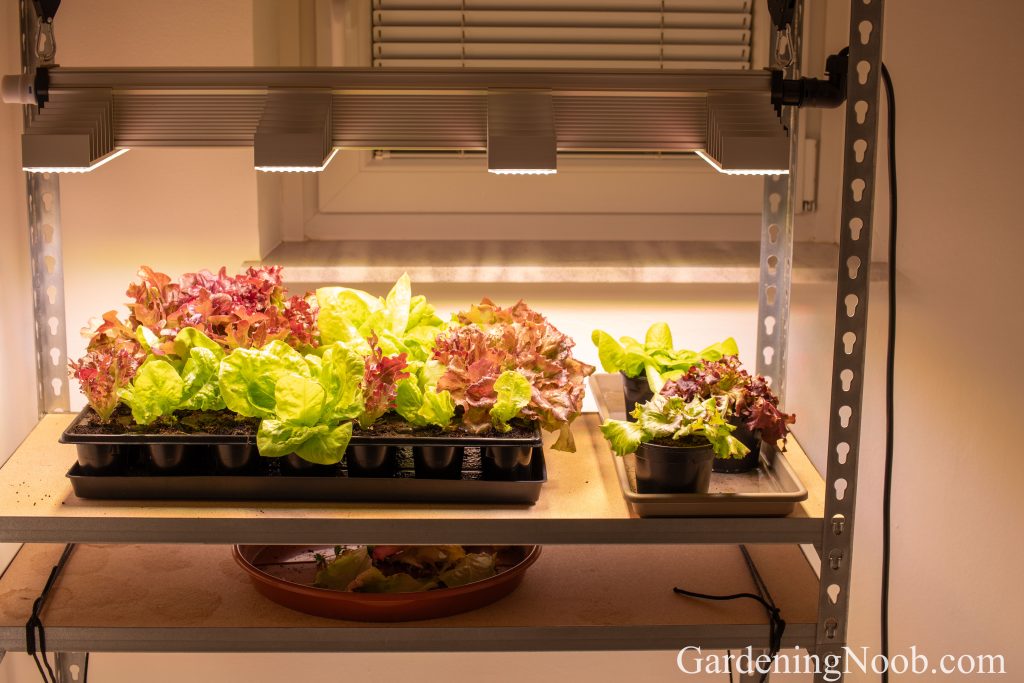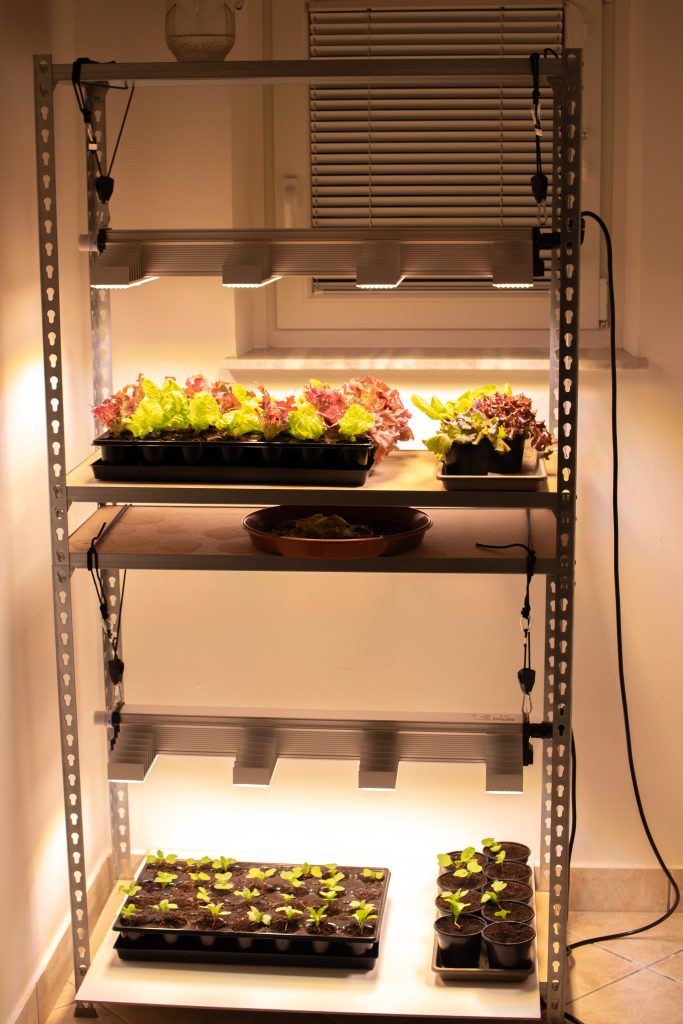Discover the details of my DIY indoor vegetable seed starting system, including its location and the equipment I use
I started growing vegetable seedlings indoors in year 2022. Until then, I had been – and continue to – grow them outdoors, mostly in the miniature greenhouses. I quickly realized that indoor vegetable seed starting is not so different from doing it outside. In fact, it is much easier. And everything I learned from my first serious vegetable seed starting season – and the next ones – I have been able to apply indoors as well…
Looking back, I am more than happy with my decision to start growing vegetable plants from seeds indoors as well. Not only is it easier, but it also perfectly complements my oudoor gardening!
Now, if you are interested in discovering all about my indoor vegetable seed starting setup – including its location and the equipment I use – that has helped me grow hundrends and hundreds of plants so far, I invite you to continue reading.
The location
I have my setup in a room that was once a laundry room. The room is equipped with an electrical outlet (socket) which I utilize to power the grow lights. It also has a water pipe which is incredibly convenient and saves me lots of time because I don’t have to carry the water from the bathroom.

The window is another cruical feature of the room. I try to keep it open at all times – even during winter when it’s freezing outside – for two different reasons:
- It keeps the room well ventilated. An open window brings in a constant flow of cool, fresh air which hardens the plants, strenghtens their stems and essentially helps prepare them for the outdoors. This is particularly important for cool-season vegetables (brassicas, lettuce, leeks, …), which thrive in cool conditions.
- It prevents the room from overheating. The grow lights I use are high-quality and designed to emit minimal heat, but they still warm the room slightly. By keeping the window open, I counteract their heating effect and manage to maintain a constant temperature of around 20 to 23 degrees Celsius (68 to 74 Degrees Fahrenheit) which I think is ideal for both warm-season and cool season vegetable seedlings.
There’s also a heating radiator in the room, but I always keep it off for the same reason as I keep the window open.
And just a thought for you to consider if you haven’t found the perfect spot for your setup yet. If we had more space in our living room, I would consider relocating my setup there. Imagine, with some adjustments – perhaps a stylish shelving rack and neatly hidden cables – it could easily become a decorative element that adds charm to the room. I’m sure that our friends and family would be delighted to see the plants growing during their visits.
The equipment

Now, let’s look at the equipment that my indoor vegetable seed starting station consists of:
One shelving rack.
The shelving rack serves as the foundation of my setup. It supports everything from grow lights, to plants (along with their pots or seed starting cell trays which are filled with soil), as well as other necessities such as glass water pitcher for watering and a round saucer designated for collecting dry leaves.

The shelving rack – as you can see – is pretty basic. You can find a similar one in any hardware store. It is roughtly two meters (6.5 feet) tall and features four shelves. Each shelf is about 1.2 meters (4 feet) long and about 0.4 meters (1.3 feet) wide and can carry about 30 kilograms (65 pounds). This load capacity is more than enough to support the weight of all the items I place on it.
While the rack meets my current needs, I might upgrade it to one with wider shelves in the future. You see, the current shelves are a bit too narrow for the lights I use. To work around this, I have extended one shelf with a wooden plate about 0.6 meters (2 feet) wide and thus gained some more valuable growing space. The downside is that plants on the edges receive less light than those in the centre, so I regularly rotate them to ensure each one gets approximately equal amount of light throughout their indoor growing phase.
When choosing the right unit, pay special attention to its load capacity. It must be sturdy enough to support the weight of everything you plan to place on it: from grow lights to plants. The last thing you would want is the rack to colapse under the weight. A good rule of thumb is to select one with a load capacity at least double what you expect to need. So, if you estimate the total weight per shelf to be 15 kilograms (33 pounds), choose one that can support at least 30 kilograms (66 pounds).
Two grow lights.
My setup includes two identical grow lights: the EVO 4-100 model by SANlight – an austrian company which specializes in premium LED grow lights. Each light is approximately 0.8 meters (2.6 feet) long and 0.3 meters (1 foot) wide and fits almost perfectly on the shelving rack.
I have hung each grow light above a shelf with rope ratchets which I bought alongside the lights. While I haven’t encountered any issues with the rope ratchets so far, I’m not entirely convinced that they are the best solution. It can be tricky to adjust them to the right height. And the metal edges of the shelving rack are slowly but surely fraying the ropes and could eventually cause them to tear.
Even though the lights were quite expensive – I paid almost 500 EUR ($530) for each grow light – I wouldn’t trade them for anything because plants love them. They are definitely worth every penny!
Extension block with multiple sockets.
I use an extension block (or power strip if you prefer) with four sockets to connect both grow lights to electricity. Given that I live in Slovenia, EU, it is obviously the european type. I purchased it at a hardware store for around 18 EUR ($20).
What I like about this extension block is that it has its own built-in power switch. I allows me to switch both lights on (or off) with a single press of a button. Another feature I like is that its sockets are covered with lids and are thus waterproof to a certain degree (IP44 rating). This is great for two reasons:
- It’s harder for my son to mess with.
- And if I accidentally get water on it while watering the plants, it’s no big deal.
I don’t have the extension block connected to a timer right now because I prefer to switch the lights on and off manually – which allows me to check on the plants’ growth each time. However, using a timer could be a smart move. It would make things easier for you and could also save you money by running the lights at night when electricity is cheaper.
Other necessities
Alongside the main setup, I keep a couple of other things on the shelves. I have a round saucer in which I collect dry leaves. Plus, there’s also a glass water pitcher handy for watering the plants. And that is essentially all I need to raise the vegetable seedlings indoors.
The conclusion
As you can see, I have a very simple Do-It-Yourself (DIY) indoor vegetable seed starting setup in place. But don’t let its simplicity mislead you. The plants love it and it is very effective in getting things done. The grow lights are definitely the cornerstone of the system. With high-quality grow lights, growing vegetable plants (or any other plants) indoors becomes a poetry, a pure pleasure!
What I love about indoor growing is that you don’t have to deal with damaging cold, there’s almost no risk of damping-off disease, and you can always check on your plants to see if they need water. And the best part is that you don’t need much space for it. With a little creativity, it can even become a decorative element in your home, blending seamlessly with your interior design.
Now, I invite you to head back to my vegetable seed starting guide to learn more about how I grow vegetable seedlings from seeds – both indoors and outdoors!
